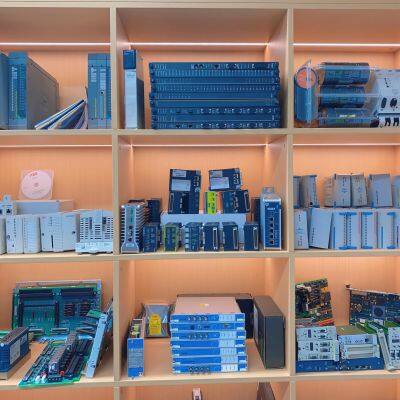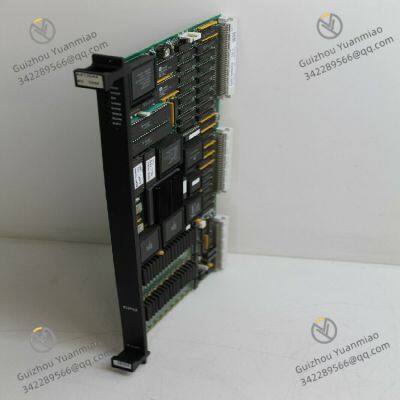Product Description
I. Overview
METSO A413044 is a general-purpose industrial control module launched by Metso, a global leader in process industry solutions. Its core positioning is to provide an integrated solution of "signal acquisition - logical operation - execution control" for heavy-duty equipment and complex processes in fields such as mining, metallurgy, building materials, and chemical engineering. As a core component of Metso's automation systems (e.g., Metso DNA, Metso Outotec equipment control systems), its essence lies in realizing real-time processing of on-site sensor signals, dynamic adjustment of equipment operating parameters, and rapid response to fault states through high-reliability hardware circuits and programmable control logic. It is particularly suitable for harsh industrial environments characterized by high vibration, heavy dust, and strong electromagnetic interference.
Leveraging Metso's technical accumulation in the field of heavy industrial equipment control, this product adopts a compact modular design with fanless heat dissipation. It is compatible with multiple types of signal input/output, including analog and digital signals, and supports seamless connection with Metso's dedicated sensors, actuators, and third-party industrial equipment. Its integrated fault self-diagnosis function and redundant design can effectively reduce the risk of unplanned equipment downtime. Combined with flexible communication interfaces and configuration software, it forms a complete control loop covering "perception - control - monitoring - diagnosis". Whether it is load control of mining crushing production lines, temperature adjustment of cement kilns, or valve linkage of chemical reactors, the A413084 can improve production efficiency and equipment reliability through precise control and stable operation, making it a key component for process industries to achieve automation upgrades.
II. Technical Specifications
(I) Signal Input/Output Parameters
Input Channel Configuration
Analog Input (AI): Supports 8 independent analog input channels, compatible with standard industrial signals of 4-20mA DC and 0-10V DC. The input impedance is ≥10MΩ (for voltage signals) and 250Ω (for current signals). It can be directly connected to on-site instruments such as pressure sensors, temperature transmitters, and level gauges, with a measurement accuracy of ±0.1% FS, ensuring accurate acquisition of weak signals.
Digital Input (DI): Features 16 isolated digital input channels, supporting 24V DC signals. The input response time is ≤1ms, suitable for status signals from devices like proximity switches, limit switches, and emergency stop buttons. The anti-interference voltage is ≥250V AC (for 1 minute), preventing false triggers caused by electromagnetic interference in industrial sites.
Output Channel Configuration
Analog Output (AO): Equipped with 4 analog output channels, optional for 4-20mA DC or 0-10V DC signals. The output accuracy is ±0.2% FS, with a load capacity of ≤500Ω (for current output) and ≥1kΩ (for voltage output). It can directly drive executive components such as control valves, frequency converters, and servo motors to achieve continuous adjustment and control.
Digital Output (DO): Provides 8 relay output channels, each with a rated load current of 5A@250V AC / 10A@30V DC. It supports configurable normally open/normally closed contacts, meeting the on-off control needs of devices like contactors, indicator lights, and solenoid valves. The mechanical life is ≥10 million cycles, and the electrical life is ≥100,000 cycles (under rated load).
(II) Electrical and Performance Parameters
Power Supply and Power Consumption
Supply Voltage: 24V DC (with ±15% fluctuation tolerance), compatible with commonly used industrial DC power modules, eliminating the need for dedicated power supply equipment.
Standby Power Consumption: ≤5W; Power consumption under full load: ≤15W. The low-power design reduces the overall energy consumption of the system, making it suitable for emergency control scenarios with battery backup.
Processing Performance
Control Cycle: The minimum control cycle is 10ms, supporting multi-task parallel processing. It can run 8 independent control loops (e.g., PID adjustment, logical interlocking) simultaneously, meeting the real-time control requirements of complex processes.
PID Function: Built-in standard PID control algorithm, supporting online adjustment of proportional (P), integral (I), and derivative (D) parameters. It has functions such as automatic/manual bumpless transfer, anti-integral windup, and alarm interlocking, suitable for closed-loop control of continuous process parameters like temperature, pressure, and flow.
(III) Environmental and Compatibility Parameters
Environmental Adaptability
Operating Temperature: -20℃~+60℃; Humidity: 5%~95% RH (no condensation). It can operate stably in high-temperature and high-humidity environments such as underground mines and metallurgical workshops without additional temperature control devices.
Protection Level: IP20 (module itself); can be upgraded to IP54 when used with Metso's dedicated sealed enclosure, effectively isolating dust and moisture, and adapting to dusty scenarios in the building materials and mining industries.
Anti-interference and Anti-vibration: Complies with IEC 61000-4-2 (ESD ±15kV air discharge) and IEC 61000-4-3 (radiated immunity 10V/m) standards. It can withstand mechanical vibration of 10-500Hz (acceleration 2g), ensuring stable signals in the vibration environment of heavy-duty equipment.
System Compatibility
Controller Adaptability: Natively compatible with Metso DNA DCS and Metso Outotec equipment control systems. It communicates with the upper computer via RS485 (Modbus RTU protocol) and Ethernet (Profinet protocol), supporting remote parameter configuration and status monitoring.
Expansion Capability: Supports multi-module cascading (up to 16 units). The input and output channels can be expanded via bus expansion, adapting to the centralized management and control needs of multiple devices in large-scale production lines and reducing spare parts inventory costs.

III. Core Functional Features
(I) High-Reliability Design for Harsh Industrial Environments
Hardware Level: Adopts military-grade components and isolated circuit design. The digital input/output channels are equipped with photoelectric isolation functions to block the impact of ground loops and electromagnetic interference on signals.
Software Level: Built-in real-time fault monitoring algorithm, which continuously performs self-tests on module power supply, communication links, and channel status. The fault identification accuracy is ≥99%, and detailed fault logs are generated. For example, in mining crushing workshops, where high dust and heavy equipment vibration impose high requirements on the stability of control modules, the A413044 can achieve continuous trouble-free operation with its anti-vibration and anti-interference design, reducing the frequency of shutdown maintenance.
(II) Flexible Control and Interlocking for Complex Processes
It has built-in rich control logic and interlocking functions, supporting custom control programs via Metso's configuration software:
It can implement interlocking logic such as "high temperature (AI1) + high pressure (AI2) → valve closure (DO1)".
It can also be configured with multi-loop PID cascade control (e.g., cascade adjustment of cement kiln precalciner temperature and coal feeding rate). In the control of chemical reactors, the module can collect reaction temperature and pressure signals through AI channels, adjust the opening of cooling water valves via AO channels after PID calculation, and simultaneously link DO channels to control the start/stop of feed pumps, realizing multi-parameter coordinated control of "temperature - pressure - flow" and preventing over-temperature and over-pressure in reactions.
(III) Convenient Operation & Maintenance and Status Monitoring
Indicator Lights: The module panel is equipped with 8 AI indicator lights (green), 16 DI indicator lights (yellow), 4 AO indicator lights (blue), 8 DO indicator lights (red), and 1 power indicator light (orange), enabling intuitive judgment of the working status of each channel.
Remote Monitoring: Through the Ethernet interface, the input/output values of each channel, PID parameters, fault codes, and other information can be read in real-time on the upper computer. When a channel fault or communication interruption occurs, alarm information (e.g., "E05: AI3 channel fault") is automatically uploaded, facilitating remote diagnosis and rapid troubleshooting and reducing on-site operation and maintenance time.
Online Firmware Upgrade: Supports online firmware upgrade without interrupting the control function during the upgrade process, ensuring production continuity.
(IV) Multi-Scenario Adaptability and Third-Party Compatibility
Environmental Adaptability: The wide temperature design of -20℃~+60℃ and optional IP54 protection allow it to cover multiple scenarios, from outdoor equipment in northern winters (e.g., control of mining belt conveyors) to high-temperature and high-humidity chemical workshops in southern regions.
Third-Party Compatibility: It is compatible with third-party sensors and actuators (e.g., Siemens temperature transmitters, Schneider control valves) without the need for additional signal conditioning modules, reducing system integration costs. In cement production lines of the building materials industry, the module can be directly connected to kiln tail temperature sensors and grate cooler pressure transmitters of different brands to achieve unified control of multiple devices.
IV. Application Scenarios
(I) Mining Industry: Crushing Production Line Control
In the crushing production line of metal mines, the A413044 plays a core control role:
Signal Acquisition: 8 AI channels are respectively connected to the level gauge at the feed inlet of the jaw crusher (4-20mA), the bearing temperature transmitter of the cone crusher (4-20mA), and the vibration sensor (4-20mA); 16 DI channels are connected to the belt conveyor deviation switch, emergency stop button, and motor overload protection signal.
Logical Control: Through configuration software, control logic such as "high level at feed inlet (AI1) → feeder deceleration (AO1)" and "bearing temperature >80℃ (AI2) → crusher shutdown (DO1)" is configured to prevent crusher overload or bearing burnout.
Interlocking Protection: When the DI channel detects belt deviation (DI1) or emergency stop signal (DI16), the module immediately triggers the DO channel to cut off the power of the feeder and crusher, and simultaneously uploads fault information to the mine dispatch center via Ethernet to ensure equipment and personal safety.
(II) Building Materials Industry: Cement Kiln Control
In the control system of cement rotary kilns, the application value of the module is significant:
Temperature and Pressure Control: AI channels collect signals of kiln head temperature (AI1), precalciner temperature (AI2), and kiln tail negative pressure (AI3). After PID calculation, AO channels adjust the kiln head coal injection rate (AO1), precalciner coal injection rate (AO2), and kiln tail exhaust fan speed (AO3) to stabilize the thermal parameters of the kiln system.
Equipment Interlocking: DI channels are connected to the kiln main motor current sensor (DI1) and supporting roller oil temperature switch (DI2). When the motor current exceeds the rated value (triggered by DI1) or the supporting roller oil temperature >70℃ (triggered by DI2), the DO channel immediately stops the feeder (DO1) and reduces the kiln speed (AO4) to prevent damage to the kiln lining.
Remote Monitoring: Control data is uploaded to the cement plant DCS system via the Profinet protocol. Dispatch personnel can remotely adjust PID parameters (e.g., PID proportional coefficient of kiln head temperature) and monitor the module operation status in real-time, realizing visual management of the production process.
(III) Chemical Industry: Reactor Control
In the control system of fine chemical reactors, the module realizes the following functions:
Continuous Adjustment: AI channels collect the reactor temperature (AI1, 4-20mA corresponding to 0-300℃) and agitator motor speed (AI2, 4-20mA corresponding to 0-1500rpm). AO channels adjust the opening of the cooling water valve (AO1) and the frequency of the agitator motor inverter (AO2). The reaction temperature is stabilized at the set value (e.g., 150℃±2℃) through PID control.
Safety Interlocking: DI channels are connected to the reactor high-pressure alarm switch (DI1) and safety valve status switch (DI2). When the pressure is high (triggered by DI1) and the safety valve is not opened (not triggered by DI2), the DO channel immediately cuts off the feed pump (DO1), opens the emergency pressure relief valve (DO2), and triggers the audible and visual alarm (DO3) simultaneously.
Data Recording: Temperature, pressure, and speed data are uploaded to the MES system via Ethernet to generate historical trend curves, facilitating process optimization and fault tracing.
(IV) Metallurgical Industry: Auxiliary Control of Steel Rolling Production Lines
In the auxiliary system of rolling mills in hot-rolled steel plate production lines, the A413044 realizes:
Roller Table Control: DI channels are connected to the roller table speed encoder (pulse signal) and steel plate position proximity switch (DI3). DO channels drive the roller table start/stop contactor (DO1) and steel plate alignment cylinder (DO2).
Temperature Interlocking: AI channels collect the temperature of the rolling mill work rolls (AI4, 4-20mA corresponding to 0-500℃). When the temperature >450℃, the AO channel adjusts the opening of the cooling water pipe valve (AO4), and the DO channel triggers the roller table speed reduction (DO3) to prevent overheating and deformation of the work rolls.
Fault Response: When the DI channel detects steel plate deviation (DI5), the module immediately stops the roller table operation (DO1) via the DO channel and uploads the fault signal to the rolling mill main control system to prevent steel plate scratches or equipment collisions.
V. Installation and Maintenance Guidelines
(I) Installation Specifications
Mechanical Installation
Install using a 35mm standard DIN rail, with a reserved gap of ≥10mm between modules to ensure smooth heat dissipation. If installed in a dusty or humid environment, it should be used with Metso's dedicated IP54 sealed enclosure, and the gap between the enclosure and the module should be ≥5mm to avoid affecting heat dissipation.
The installation location should be far away from strong electromagnetic interference sources such as high-power frequency converters and high-voltage cables (distance ≥50cm), and should avoid direct contact with heat sources (e.g., heaters, motors) to prevent the ambient temperature from exceeding the range of -20℃~+60℃.
Electrical Wiring
Use 0.5-2.5mm2 copper-core cables for input and output cables. Use shielded twisted-pair cables for analog cables (with the shield layer grounded at one end, grounding resistance ≤4Ω). Unshielded cables can be used for digital cables, but they should be routed separately from power cables (distance ≥15cm) to reduce electromagnetic interference.
A surge suppressor (e.g., RC absorption circuit) should be installed at the relay output end to prevent damage to the module caused by reverse electromotive force generated when inductive loads (e.g., motors, solenoid valves) are powered off.
The power cable should be equipped with an independent air switch (rated current ≥1A). During wiring, strictly distinguish between the positive (+) and negative (-) poles of the power supply to avoid burning the internal circuit due to reverse connection.
(II) Maintenance and Troubleshooting


Metso Valmet A413075 Ver.08 Field Bus Controller
Metso Valmet A413076 FBC Field Bus Controller
Metso Valmet A413659 Control Module
Metso Valmet A413325 Rev. 08 Metso Valmet PLC Board
Metso Valmet A413040 DCU Board
Metso Valmet A413046 PLC Board
Metso Valmet A413062 DMU Unit V.07
Metso Valmet A413230 ECU Ethernet Connection Unit
Metso A413665 Control Module
Metso A413381 SCSI Unit 2 x HDD NEW
Metso Valmet A413152 Control Module
Metso Valmet A413125 AIU-8 Analog Input Module
 yezi
Hi there! Welcome to my shop. Let me know if you have any questions.
yezi
Hi there! Welcome to my shop. Let me know if you have any questions.


